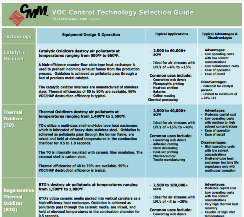As a leader in pollution control and thermal processing equipment, The CMM Group knows a thing or two about what’s hot in the manufacturing world and as a leading provider of pollution control equipment, ovens, dryers, and food manufacturing systems, we would like to take a second to look back, thank our clients, and offer a few insights you may have missed.
Today, we would like to share some of our top resources, namely our most popular articles this year and the ones on the way up. The following 20 articles are broken into our most searched and read content and our best reads during the last year, and we’re excited to share both.
Our 10 Most-Read Blogs
At The CMM Group, we understand that a well-informed customer is going to know how to pick the right pollution control equipment for their business, and have designed our blog around your education. Whether that’s a look into the processes or the regulations, our top 10 blogs answered all of the most pressing pollution control questions.
How to Reduce Air Pollution from Factories and Industrial Operations
There are thousands of industrial facilities around the world, all of which contribute to producing billions of consumer products. While these products may be extremely helpful, their production also puts a huge amount of stress on the environment and our health. Many countries regulate air pollution outputs, and there are many ways to control it. In this blog, we explore Common airborne pollutants generated by industrial operations and discuss how you can take steps to reduce your output.
Learn More: How to Reduce Air Pollution from Factories and Industrial Operations
How Does a Regenerative Thermal Oxidizer Work?
The Regenerative Thermal Oxidizer is built to keep costs low, destruction efficiency high, and factories compliant. Do you ever wonder how one of the most popular pieces of pollution control equipment works? In our aptly titled article, we explore the process of turning polluted exhaust into clean air and discuss how this keeps your business running effectively. Learn more in How Does a Regenerative Thermal Oxidizer Work?
The Three T’s of Pollution Control
In chemistry, combustion is a basic equation meaning “the reaction of oxygen with anything.” When applied to propulsion (internal combustion engines), heat generation, or pollution control, combustion is understood to be the reaction of oxygen with a compound containing carbon and hydrogen. In this blog, we go back to class, exploring the chemistry of combustion and why time, temperature, and turbulence are important to destroy pollutants.
Learn more here: The Three T’s of Pollution Control
Everything You Need to Know about Industrial Drying Ovens
Industrial ovens are among the most common pieces of equipment found in factories across the US. Simply known as dryers, these versatile pieces of machinery can be used for an array of reasons across a multitude of industries.
Get to know more about how these products work in our blog: Everything You Need to Know About Industrial Drying Ovens.
What is a Regenerative Thermal Oxidizer?
A Regenerative Thermal Oxidizer (RTO) is an industrial system that destroys volatile organic compounds (VOCs) in process exhaust air before it pollutes the environment. Historically, RTO’s have been used extensively in industries producing a high waste stream containing low VOC concentrations such as paint manufacturing, printing and food processing, among others. But how do they work? We explore this in great detail, answering the questions you may have when considering one of these solutions for your facilities.
Learn more in What is a Regenerative Thermal Oxidizer?
How to Select the Right VOC Abatement System for Your Operation
You’re required to choose a pollution control product, but how can you select the right one for your needs? It all depends on how your business works. In part 1 of this 2-part series, we’re covering an overview of today’s modern VOC abatement systems including RTOs, Thermal Recuperative Oxidizers, and Catalytic Oxidizers.
Learn More in How to Select the Right VOC Abatement System for Your Operation
The Science of Pollution Control: Destruction Efficiency
Destruction efficiency is, in simple terms, the effectiveness to which an oxidizer works. Sometimes referred to as destruction and removal efficiency (DRE), this is a percentage that represents the number of molecules of a compound removed or destroyed in an oxidizer relative to the number of molecules that entered the system. (For example, a DRE of 99.99 percent means that 9,999 molecules are destroyed for every 10,000 that enter.
Get to know more about how to calculate this and why it matters for your industry needs here: The Science of Pollution Control: Destruction Efficiency
The Importance of Manufacturing Equipment Maintenance
Unexpected equipment failure in a manufacturing plant can interrupt the production schedule and lead to costly downtime that can impact your bottom line significantly. Maintaining your equipment can keep costs low and deliver higher return on investment. Learn some of the long-term benefits of this, get to know what’s involved in the maintenance process, and how to complete maintenance here.
What Does a Regenerative Thermal Oxidizer Design Look Like?
Regenerative Thermal Oxidizers destroy VOC emissions by creating a chemical reaction within the air pollutant and oxygen at elevated temperatures. How are these designed for optimal efficiency and how do they use time, temperature, and turbulence to accomplish the task they are designed to accomplish?
Learn more: What Does a Regenerative Thermal Oxidizer Design look like?
The Current and Future Challenges Surrounding Air Pollution Control Abatement
It’s no secret that air pollution is extremely dangerous for both the general public and the environment. This is one of the reasons why the Clean Air Act of 1970 was established in the first place – to help improve public health while reducing the impact humans have on the natural world. However, as the document evolves, it’s on you to adapt, and in this article, we explore how the changes impact you.
Learn more: The Current and Future Challenges Surrounding Air Pollution Abatement
Hot Blogs: 10 Posts Released in the past year you need to read
While these were written over the course of our existence, these posts are definitely worth the read:
- How to Maintain a Regenerative Thermal Oxidizer (RTO) Effectively: Explores how to keep your VOC abatement solution running efficiently and cost effectively.
- How to Reduce VOC Emissions From Paints and Coatings: Discusses the challenges faced by the paint and coatings industry and looks at some of the most effective ways to minimize emissions.
- Understand the Differences between VOCs, VVOCs, and SVOCs: What are the differences in how each brand of VOC affects the environment? We look at the different categories and how to fight each.
- Regenerative Thermal Oxidizers: Random vs. Structured Media: One of the decisions you’ll come across when looking at an RTO is whether you want random or structured media. What are the differences?
- Building a Sustainable Manufacturing Operation: In today’s litigious and media-driven landscape, sustainability is the name of the game. How does it differ from compliance and what can you do to become sustainable?
- Abatement Strategies for Controlling Emission and Air Pollution: What are some of the ways you can reduce and control emissions at your facilities? We explore in our popular 2019 blog.
- How to Know Which Oxidizer Is Best For Your Business: There are two types of oxidizing control systems: catalytic and thermal. Which one fits your process and how can you decide on the right solution?
- What’s Next for the Packaging Industry: Few industries can say that every single American uses their products multiple times per day. For packaging, it’s all about knowing what’s happening—but you can’t ignore the basics.
- 4 Steps To Choosing the Best Industrial VOC Abatement Solution: The right solution can save you time and money, but if you go into the process blind, you can easily get lost. We explore 4 best practices for choosing a product that works for you.
- How to Create an Effective Preventative Maintenance Plan for Your Pollution Control Equipment: There are many ways to keep your pollution control equipment running effectively. Preventive maintenance can keep costs low, and we explore some tips to make this work.
Our Newest Guides: Deep Dives You Need to Read
In addition to our blogs, we released a variety of content designed to share in-depth content on how to improve your manufacturing processes:
Selecting, Purchasing, Installing, and Using a Cheese Melter: A Guide for Food Manufacturers
From production to packaging to distribution to retail, your product will get bumped, dropped, thrown, stored sideways, and jostled before a consumer even sees the product. How can you keep everything in place? Cheese pre-melters have quickly become part of many frozen or refrigerated food manufacturers’ lines.
These unique products are a truly unsung hero, providing a food-safe way to hold ingredients in place and ensure that a customer’s expectations are met. In this guide, you will learn more about the role that these products play in food manufacturing and discover the buying process for this machinery. Click here to learn more.
VOC Abatement Guide for the Paint Industry
Volatile Organic Compounds are a major talking point for a variety of reasons, but primarily for the risks they pose for the health of people exposed to the chemicals and the environment at large. From indoor VOCs—responsible for negative health effects on your employees (and in the case of some architectural paint, your customers) to outdoor VOCs, these compounds pose health, environmental, and economic risks when they escape your facility.
The paint industry has long been known for its impact on the environment. Solvents and resins naturally release VOCs during manufacturing, application, and degassing, whether the paint is being used to coat an automobile, mark a road, or cover a wall. But let’s take a step back to look at the basics of VOCs and HAPs—what they are, what impacts they have on health and the environment, and why it’s so important that paint manufacturers continue to lead the way in VOC abatement.
The CMM Group: Here for Your Pollution Control Needs
We’ve been doing this for nearly 2 decades and would love to help you. As a leader in the pollution control and industrial equipment market, we know how to help clients in a variety of industries get something that lowers costs, increases efficiency, and keeps them compliant. Contact us to learn more.






